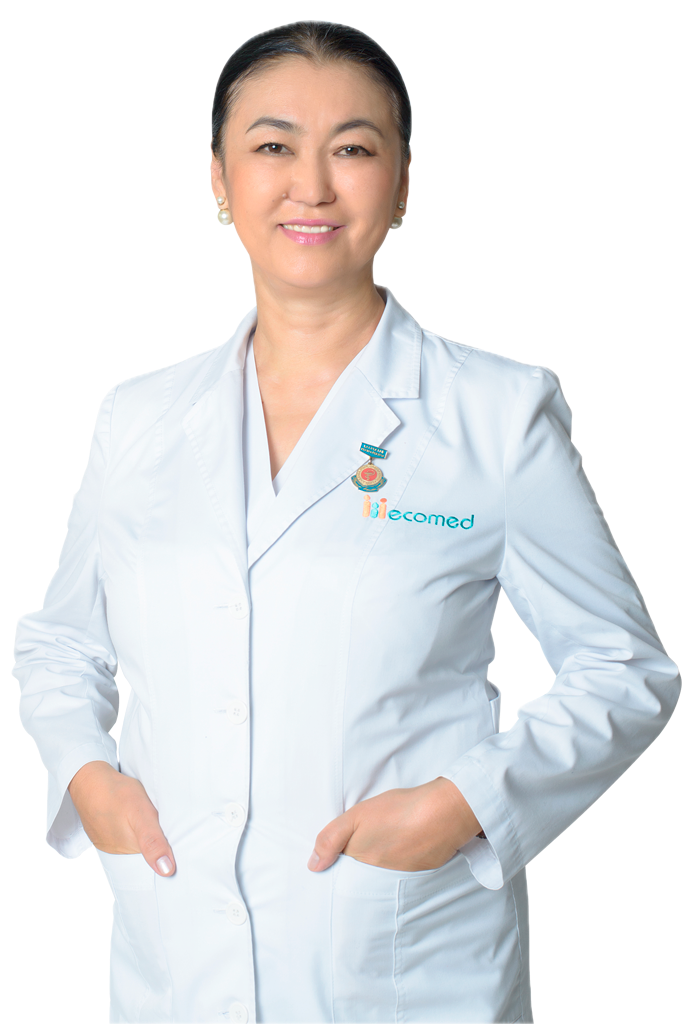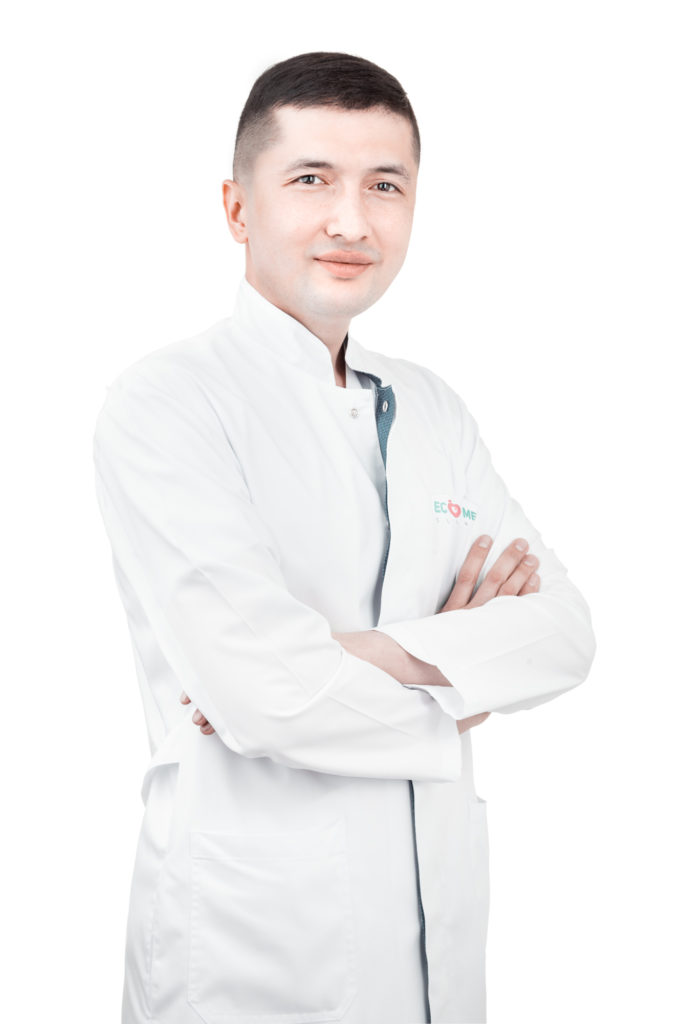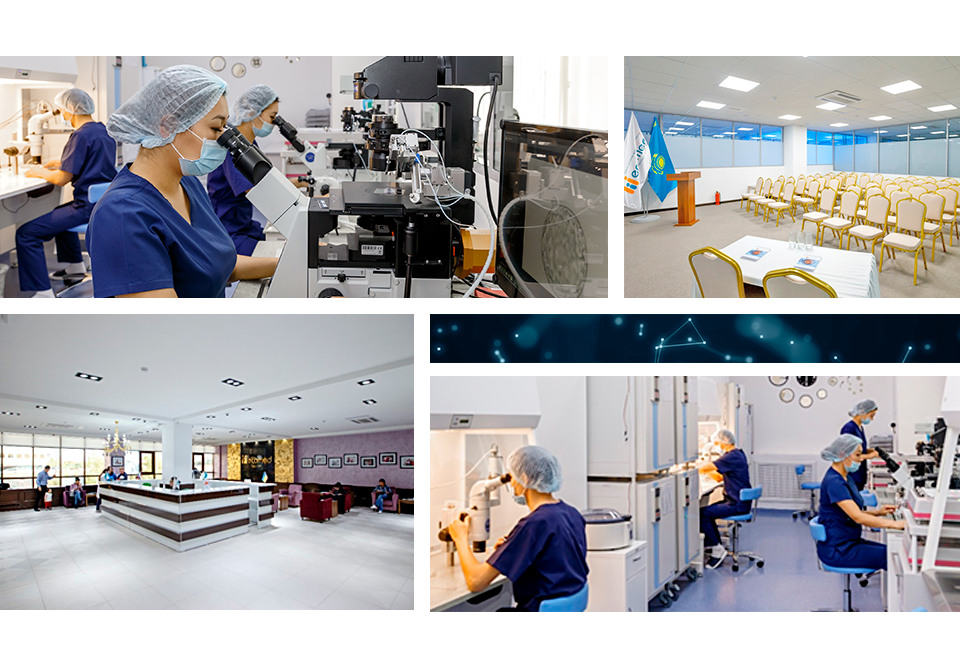
The Academy of Innovative Reproductive Technologies – Ecomed, hereinafter referred to as the Academy, is an independent legal entity established on January 25, 2010, in Almaty. Its mission is to provide professional development and training in the fields of obstetrics, gynecology, reproductive medicine, andrology, embryology, and genetics. The Academy aims to transfer knowledge and experience in the most innovative technologies, both in theory and practice, in alignment with the standards for supplementary education organizations in the Republic of Kazakhstan.
In October 2019, it was re-registered due to a change in the name and location, which moved to Astana.
The mission of the Academy is to organize and deliver high-quality educational services for the advanced training and education of medical personnel and specialists in the field of reproductive health. It aims to enhance the professional competence of participants in the educational process in accordance with national and international quality and safety standards. This mission is based on the integration of education, science, practice, and innovative approaches, all in the best interests of individuals, society, and the state, while adhering to the principle of educational continuity.
The Academy of Innovative Reproductive Technologies, as an organization providing supplementary education, stands as one of the leading educational centers in the field of reproductive health within the republic.
The Academy ensures high quality in the system of ongoing postgraduate education by implementing innovative teaching technologies, information and communication technologies, and by utilizing the evidence-based findings of modern scientific research.
The Academy’s students competently compete in the field of reproductive health and successfully work in in vitro fertilization clinics, both within the country and in countries in the near and distant regions.
The Academy, in close collaboration with the Educational Center of the IWI Network of Reproductive Clinics in Spain, as well as partners within the Ecomed Clinic group, actively engages with the European and global educational and scientific community.

Candidate of Medical Sciences, Master of Business Administration, obstetrician-gynecologist with the highest qualifications, and health care manager with the highest qualifications.
Dear listeners, colleagues, and our partners!
Reproductive health is a branch of medicine that not only examines the state of the human reproductive system but also considers the overall well-being of the body, including physical, emotional, and social health. While obstetrician-gynecologists, urologists, andrologists, endocrinologists, and embryologists have traditionally been responsible for reproductive health, this field is now starting to garner the interest of doctors from various other specialties.
Reduced fertility and, eventually, infertility are common issues. According to official statistics, in Kazakhstan, 15 to 18 percent of married couples experience infertility.
The real challenge in applying global scientific expertise in our country is that the principles of evidence-based medicine, which are widely utilized in clinical practice by internists and surgeons, have not yet found a significant place in reproductive medicine. Consequently, our primary focus will be to explore global reproductive trends and assess the feasibility of new practices from an evidence-based medicine perspective.
We believe that addressing issues related to infertility necessitates significant investments in one’s own education and professional experience. From this perspective, we view our mission as the need to organize and structure contemporary scientific knowledge, incorporate it into clinical practice, and make it readily accessible to a broad spectrum of healthcare professionals. By involving various specialists such as endocrinologists, obstetrician-gynecologists, andrologists, geneticists, embryologists, cardiologists, and others, we aim to unite the expertise of professionals in the management of conditions associated with reduced fertility and to define the most effective strategies for prevention and treatment.
The main goal of the Ecomed Academy of Innovative Reproductive Technologies (hereinafter referred to as the Academy) is the development of reproductive medicine and training of doctors in the latest advanced innovations in the field of reproductology, embryology and laboratory genetics.
At present, the Academy collaborates with the leading universities in the country:
I hope that the continuity of medical care, timely prevention and correction of reproductive disorders will not only solve problems, but also effectively prevent them in the future.

Доктор биологических наук, зам ген директора по науке

Магистр медицины, специалист в области репродуктологии высшей категорий

Ведущий эмбриолог “Экомед”
г. Алматы

Ведущий эмбриолог “Экомед”
г. Астана

Infertility is a global issue, affecting people in every country without exception. According to data from the World Health Organization (WHO), 60-80 million individuals worldwide experience infertility. In various countries, 13-19% of married couples, or approximately every 6-8 families, encounter difficulties with conception. For instance, in the United States alone, 5-6 million couples seek infertility treatment each year. In Kazakhstan, statistics show that one in every five married couples is dealing with infertility.
Infertility within marriages is among the most significant and intricate medical, social, and demographic challenges. The examination of the physiological and pathogenic aspects of male and female infertility necessitates a comprehensive study of the conditions within married couples. This study should include an analysis of criteria and factors that influence successful outcomes in overcoming infertility. It should also encompass the development, implementation, and enhancement of assisted reproductive techniques for diagnosing and effectively treating this condition. Most importantly, it should involve a profound understanding of the physiological processes involved in human reproduction. Hence, population studies in the field of reproduction, especially those involving factor analysis, are of utmost importance in comprehending specific aspects of the causes and development of infertility. It is worth emphasizing that addressing this issue necessitates a multidisciplinary approach, bringing together various fields including gynecology, andrology, embryology, physiology, and endocrinology. This interdisciplinary approach underscores the significance of adopting a comprehensive strategy to effectively tackle this problem.
Subtopics:
1) The etiology of infertility;
2) Infertility diagnosis algorithm;
The limited effectiveness of methods aimed at restoring natural human fertility has spurred the development of artificial insemination techniques, including in vitro fertilization followed by the transfer of embryos into the mother’s uterine cavity. However, it was only after more than 40 years of intensive research that the first report of the birth of the world’s first child conceived through “in vitro” methods was published.
Today, the method of overcoming infertility through in vitro fertilization of preovulatory oocytes and the transfer of developed embryos into a woman’s uterine cavity is increasingly prevalent worldwide. Initially, the IVF method was employed for the treatment of absolute tubal female infertility, which means the absence of both fallopian tubes. Subsequently, the indications for this method expanded, encompassing conditions such as disruptions in specific hormonal mechanisms of the reproductive system and a range of other factors. Presently, it is also used for relative female infertility, including cases of fallopian tube obstruction or functional impairment, endocrine-related infertility, unexplained infertility, and male infertility.
Subtopics:
The regulation of ovarian hormonal function is carried out by a complex multi-component neuroendocrine system that includes neurotransmitters, which are nerve impulse transmitters from higher centers of the central nervous system (endogenous opioids, dopamine, norepinephrine, serotonin); releasing hormones or gonadotropin-releasing hormones (luteinizing-releasing hormone, follicle-releasing hormone) secreted by nerve cells in the hypothalamus, which stimulate the release of gonadotropic hormones from the anterior pituitary gland: gonadotropic hormones (luteinizing hormone and follicle-stimulating hormone), as well as prolactin, ovarian hormones, primarily estradiol, the secretion of gonadotropin-releasing hormones from the hypothalamus and gonadotropic hormones from the anterior pituitary gland being stimulated or inhibited depending on the amount of estradiol through a feedback mechanism; receptors for sex and gonadotropic hormones in the cells and tissues of the reproductive system (including luteinizing hormone receptors on the cell membrane and follicle-stimulating hormone receptors on granulosa cell membranes); steroid-binding globulins – special plasma proteins that control the access of hormones to their receptors (receptors interact only with hormones not bound to specific globulins).
Gonadotropin-releasing hormones, released from the median region of the hypothalamus in an hourly rhythm, enter the portal veins of the pituitary gland through the processes of nerve cells and reach its anterior lobe via the bloodstream. Under the influence of these hormones, gonadotropins (luteinizing hormone and follicle-stimulating hormone) are released from the pituitary gland in a specific rhythm, with a peak (ovulatory peak) occurring at the time of the highest estradiol concentration in the preovulatory follicle. Gonadotropin-releasing hormones also contribute to an increase in inhibin production in the follicles, which inhibits the release of follicle-stimulating hormone, and the formation of progesterone. Simultaneously, there is a decrease in estradiol synthesis in the granulosa cells of the ovulated follicle, which, in turn, stimulates the release of gonadotropins.
According to the WHO classification, there are 16 causes of male and 22 causes of female infertility.
The male factor is considered the cause of infertility in a marriage when the woman is healthy, and the man experiences issues with the fertilizing capability of his sperm, sexual or ejaculatory function pathologies. Male infertility accounts for approximately 30% of cases in infertile marriages.
If the cause of infertility is attributed to a woman’s health condition, it is referred to as female infertility (constituting 30% of cases). When there is a disruption in hormonal regulation, it is diagnosed as an endocrine form of infertility. In cases where there is a lack of or obstruction in the fallopian tubes, it is referred to as tubal infertility.
In 3% of married couples with normal reproductive system function, infertility may be attributed to immunological incompatibility, where antibodies are produced in the woman’s body that neutralize the partner’s sperm.
Finally, infertility can also occur among perfectly healthy and compatible married couples. These cases are referred to as idiopathic (unexplained) infertility.
Until recently, developments and technologies in the field of assisted reproductive medicine primarily focused on issues of female infertility, while male infertility, which represents a significant portion of this group (the male factor is identified in 30-40% of infertile couples), has not received adequate attention in recent years. Analytical techniques used to this day were developed in the 1960s and have become outdated, often failing to accurately identify the true cause of infertility. This lack of attention to the male factor has resulted in a low pregnancy success rate and a high likelihood of early termination.
Here’s a corrected version of your statement:
In cases where spermatozoa are absent in the ejaculate, it is possible to retrieve them directly from the testicles (TESE = testicular sperm extraction) or from the epididymis (MESA = Microsurgical epididymal sperm aspiration). Sperm for use in fertilizing an egg in cases of azoospermia can be obtained not only through open testicular biopsy but also through percutaneous testicular biopsy. Typically, preimplantation genetic diagnosis (PGD) is performed on resulting embryos because scientific studies have shown that the probability of genetic abnormalities in spermatozoa is significantly elevated.
As you may be aware, at birth, a girl’s ovaries contain a specific number of primordial follicles, which deplete over time. The proliferation of primordial cells in a female fetus occurs until the fourth month of gestation. It has been observed that the maximum reserve of primordial follicles is around 7 million. Upon reaching this level, their number decreases to 1-2 million by the time of birth. It has been observed that from a girl’s birth to the age of 40, the number of primordial follicles gradually decreases from one million to 10 thousand in each ovary. Most follicles undergo atresia during the small antral stage. It’s important to note that pronounced atresia becomes more significant around the ages of 37-38, adding to the overall process of primordial follicle atresia and considerably accelerating the decline of follicles in the ovaries. After the age of 40, the rate of follicle loss accelerates even further, and by the age of 50, there are very few remaining. Our understanding of the processes that control these three “age corridors” in ovarian life is quite limited. The timing of ovarian function cessation may depend on both the size of the ovarian reserve and the rate of atresia.
The primary and defining stage of the IVF program is the superovulation stimulation, which involves obtaining a larger number of eggs (typically 5-10) through the use of estrogen antagonists like clomiphene and human menopausal gonadotropins (hMG), which include follicle-stimulating hormone (FSH) and luteinizing hormone (LH). Various superovulation stimulation protocols are employed in IVF programs. The necessity for superovulation stimulation arises from the fact that, during a single menstrual cycle, a woman typically produces no more than one egg on average. The success rate of IVF without the use of stimulation in a natural menstrual cycle is relatively low, typically less than 10%.
Hence, ovarian stimulation using gonadotropin preparations is one of the most crucial methods to enhance the effectiveness of IVF. It enables the activation of physiological mechanisms responsible for the growth and maturation of follicles in the ovary. Consequently, it creates conditions for obtaining a greater number of mature oocytes during the puncture procedure, and following fertilization, it results in the development of “promising” embryos for implantation. This approach can significantly boost the pregnancy success rate in IVF cycles, increasing it to approximately 30-40%.
In the current stage of IVF development, the execution of this program often results in the generation of a significant number of embryos. Modern advancements in reproductive technologies have led to the emergence of new approaches to infertility treatment, including embryo cryopreservation. This technique not only provides a practical solution for preserving and utilizing surplus embryos from IVF cycles but also facilitates the synchronization of endometrial development with embryo development, thereby enhancing the efficiency of ART programs. Vitrification, a cryopreservation method, offers high prospects for the survival of embryos at various stages of development.
The success of ART is contingent on the meticulous preparation of patients for the IVF program. The first stage involves identifying any concurrent gynecological, endocrine, or other pathologies, while the second stage focuses on their elimination. In accordance with the established screening criteria, which were approved by the Ministry of Health of the Republic of Kazakhstan on January 7, 2005, married couples undergo a health assessment before participating in the IVF program. The obligatory evaluation includes both general and specialized gynecological examinations.
Every person’s body is unique, and as a result, there is no one-size-fits-all rule for treatment. Medications and dosages are selected and prescribed on a strictly individual basis. Nevertheless, even with a well-informed individual approach to each patient, complications can still occur. If the initial signs of complications manifest, it is crucial to promptly inform the attending physician.
Possible complications of IVF include:
Modern medical technologies are increasingly enabling couples with low reproductive health indicators to address the issue of infertility. Many women who turn to IVF technology often have significant reproductive system disorders. A woman’s body, in need of reproductive technologies, may not be able to sustain a pregnancy without skilled medical assistance. Consequently, 22-44% of uterine pregnancies cannot be successfully maintained. The likelihood of pregnancy termination depends on the woman’s age (less than 35 years – 10.5%, 35-39 years – 16.1%, more than 40 years – 42.9%) and the type of pathology that led to infertility.
The advent of assisted reproductive technology (ART) has allowed for the exploration of human oocyte fertilization mechanisms and early embryogenesis characteristics. The majority of human oocytes obtained through in vitro fertilization (IVF) are mature at the metaphase II (MII) stage, though it is also possible to obtain immature oocytes at the embryonic vesicle or metaphase I (MI) stage. Immature oocytes may subsequently lead to the development of abnormal zygotes. Visual assessment of zygotes at the pronuclear stage does not always provide an accurate indicator of embryo potential and the evaluation of their genetic makeup.
Currently, the primary objective in reproductive medicine is the judicious utilization of human gametes and embryos within ART programs. This challenge can be addressed deliberately through two approaches. The first method involves limiting the retrieval of biomaterial by employing gentle or minimal ovulation stimulation protocols. The second approach is refraining from stimulation and using natural cycles, which yield minimal gametes and, consequently, embryos. However, these methods come with their drawbacks, such as relatively lower efficiency, selective patient suitability, insufficient biomaterial availability for preimplantation genetic diagnosis programs, and imperfect individualization of protocols, among others.
In response to these challenges, cryopreservation technologies for gametes and embryos have experienced rapid development in recent decades. The continuous progress in the field of cryobiology has given rise to the emergence of vitrification methods. Vitrification has enabled the successful freezing and thawing of “capricious” and delicate objects, such as human oocytes. In February 1997, an Italian clinic reported the birth of a healthy girl following Intracytoplasmic Sperm Injection (ICSI) using a frozen and thawed oocyte. Cryopreservation technology not only offers the potential for the judicious utilization of biomaterial but also, in the case of oocyte vitrification, holds the promise of preserving reproductive potential indefinitely. This is particularly valuable in cases where there is a risk of ovarian function loss, whether due to malignant neoplasms or certain social reasons. However, it is important to acknowledge that vitrification’s success depends on the quality of the oocytes.
Preimplantation genetic diagnosis (PGD) represents a novel frontier in genetic testing and assisted reproductive technologies. This diagnostic method enables the examination of chromosomal abnormalities and monogenic defects in human embryos, offering an exceptionally effective strategy for the prevention of hereditary disorders.
Initially proposed as a research procedure in 1990, PGD has now become increasingly prevalent in the clinical practice of assisted reproductive technologies (ART). According to the ESHRE PGD Consortium, an international organization dedicated to analyzing PGD cycles worldwide, 12,397 PGD cycles were performed in 2008, resulting in the birth of 1,988 children.
Currently, two primary areas of PGD are in development: PGD for chromosomal disorders (aneuploidy screening) and PGD for high genetic risk (gene defects and chromosomal rearrangements). These different PGD types have distinct indications for use and methods of analysis. The primary objectives of PGD include the reduction of genetic risk concerning chromosomal and gene-related diseases. Additionally, discussions revolve around enhancing the effectiveness of ART programs through aneuploidy screening. The issue of preimplantation sex selection without medical indications remains a topic of debate. As an efficient method for selecting the most viable embryos, PGD can also act as a basis for transferring fewer embryos, thereby decreasing the incidence of multiple pregnancies. In all PGD cases, it is advisable to provide genetic counseling during the phases before PGD and before the embryo transfer. Patients should receive comprehensive information about the extent and procedure of the intended genetic investigations, as well as the potential genetic statuses of the embryos.